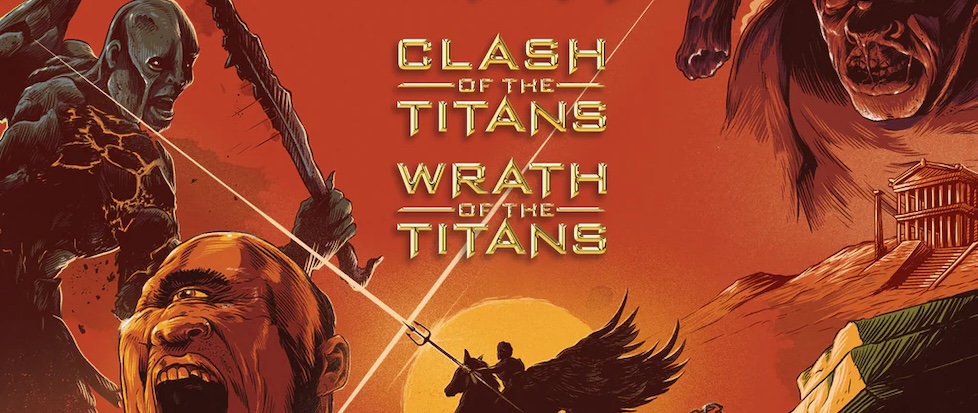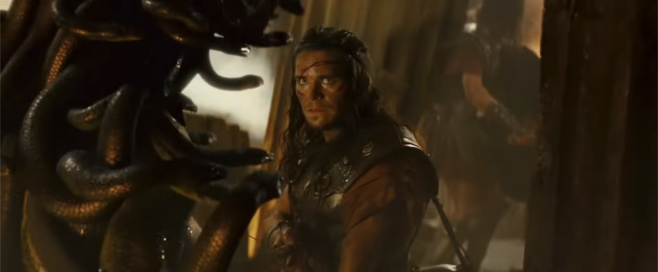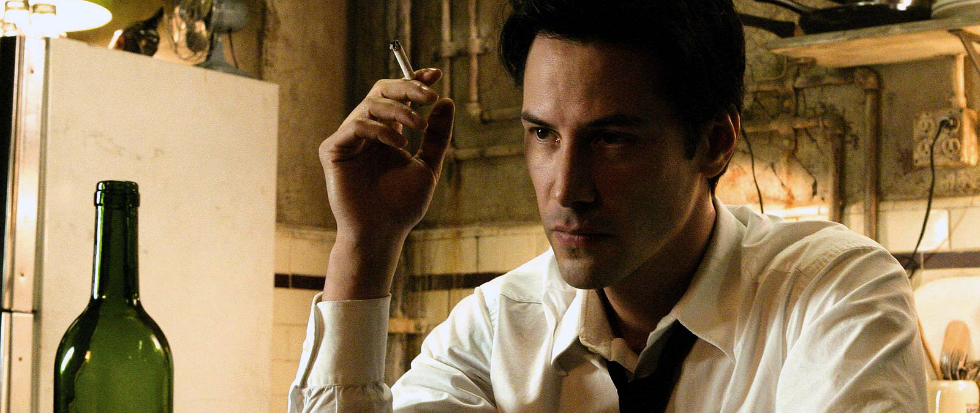
No Gods, No Masters: When Titans Ruled Blu-ray
Somewhere around here I have a generic Blu-ray three-pack that contains the original Ray Harryhausen Clash of the Titans from 1981, the 2010 remake, and that film’s sequel, Wrath of the Titans from 2012. I got it because, at that time, it was the easiest way to get the ’81 version on Blu-ray. When Arrow announced their When Titans Ruled the Earth set, I assumed that it was going to be a fancier version of that earlier collection.
I was wrong on that score. While When Titans Ruled the Earth is a much fancier release of both Wrath of the Titans and the 2010 version of Clash, the Harryhausen original is nowhere to be found. This is a bummer for a number of reasons, not least because the ‘81 film would make this entire package feel both more complete and more obligatory. However, it also gives us an opportunity to view and judge the 2010 Clash of the Titans and its sequel outside the shadow of Harryhausen’s classic, as much as such a thing is ever possible.
“When I spit in the eyes of the gods, then I’ll smile.” – Clash of the Titans (2010)
At one time, I had relatively high hopes for Louis Leterrier as an action director. It’s been close to two decades since I watched any of them, but I remember the first Transporter film being a lot of fun, and I quite liked his 2005 Jet Li follow-up Unleashed at the time. Even the Ed Norton Incredible Hulk showed some remarkable economy of storytelling and a couple of nice action beats.
Clash of the Titans was obviously Leterrier working at a scope and scale that he had not previously attempted – leaving aside that Incredible Hulk apparently cost a little bit more than Clash’s reported $125 million budget – and, as is the case with many directors, his talents with cheaper movies didn’t necessarily always translate into more expensive ones. (He has since directed the tenth installment in the Fast & Furious franchise, with a budget that almost crests $400 million, but I haven’t seen it yet, so I can’t say how that went for him.)
While Leterrier’s Clash of the Titans is not exactly well-regarded (it has a 27% on Rotten Tomatoes), it acquitted itself nicely at the box office, raking in something like $500 million, enough to guarantee the 2012 sequel that we’ll be talking about here shortly.
In some ways, Clash of the Titans is doomed to also-ran status by the stature of its predecessor. Ray Harryhausen’s 1981 film is not only his last major feature, it is also one of his most ambitious, with a full eight creatures, among them some of his most iconic, including his snake-tailed Medusa, the massive Kraken, and others.
Like a lot of people my age, Clash of the Titans was also my first Harryhausen, and quite possibly my first real introduction to stop-motion, so it holds a special place in my pantheon.

Leterrier’s Clash of the Titans will never be for anyone the transformative experience that the 1981 original was for so many of us, not least because it simply isn’t as good. Though there are things to recommend Clash 2010, they are undercut at almost every stage by… well, almost everything.
Standing at both the literal and figurative center of the movie’s problems is the fact that Clash of the Titans came out during the baffling moment when Sam Worthington was being cast as the lead in everything. Whatever your feelings about Worthington in general, he seems almost pitiably miscast as Perseus, even before someone made the bewildering decision to shave his head and make him look like a Marine amidst the surroundings of people sporting more standard sword-and-sandal ‘dos.
It doesn’t help that Worthington shares much of his screentime with Mads Mikkelsen, who is bringing vastly more than is needed to what would otherwise be a one-note character. In fact, the cast surrounding Perseus is stacked, though few of them have much of anything to actually do most of the time.
As easy as it would be to blame the shortcomings of Clash of the Titans on its star, however, there is only so much Worthington could have ever done to elevate what was happening. The fact is that Clash 2010 is just a mess. Scenes haphazardly stumble into one another as the characters seem to teleport from one region to the next, running from the depths of a forest to a trackless desert with the power of a jump cut. And though they are given a ticking clock to save Argos from the Kraken, there is no more sense of time or urgency than there is of geography.
Where Clash acquits itself surprisingly well is in the number of practical monsters on screen. Sure, there are also boatloads of CGI, bringing to life giant scorpions (who seem to alter in size from shot to shot), shrieking harpies, the slithering Medusa, and the kaiju-sized Kraken. But around them are some decent practical creatures, including the Stygian Witches, who are particular standouts and look like they crept in from some nearby Guillermo del Toro film.
The original Clash of the Titans made many deviations from actual Greek mythology, and this one makes many more, also opting to veer from the details of the 1981 film in numerous places. Despite the presence of Gemma Arterton as Io, giving us our one obligatory “badass” female character, several of the alterations also manage to make things more misogynistic, rather than less.
Perhaps the most interesting change that Clash 2010 makes to the narrative is one that, unfortunately, it also mostly abandons by the end. While the instigating incident of the 1981 original is an elaborate series of boasts, betrothals, and betrayals that feel right out of myth (even when they’re not), the 2010 version places the doom of Argos squarely on the shoulders of a “war” between the humans and the gods.
This conflict could easily be read as anti-authoritarian, with the gods demanding that humans be grateful for the simple fact of existing, while the humans are “tired of being thankful for scraps.” In this reading, Perseus’ stubborn refusal to use the gifts of the gods could be played effectively as a message that our oppressors will never willingly give us the tools to stop their oppression.

Ultimately, though, this is not a movie about collective action or anti-monarchism. It’s a hero’s journey, and sooner or later Perseus is going to use those gifts, meaning that all his posturing about not doing so earlier just got a bunch of blue-collar soldiers killed for no reason. That’s not the only way the movie walks back its vague gestures toward an anti-authoritarian reading, either. By positioning Hades as a standard fantasy movie bad guy, the film’s ending largely exonerates the gods of their failings.
Though it ultimately goes nowhere, this thematic thread is probably the single most interesting thing about Clash 2010. It’s not the thing that stuck out to me most on this watch, though. This time, what struck me the most was the score, which is by Ramin Djawadi and which is obviously his dry run for the much more effective compositions of Pacific Rim. What works like gangbusters there is still under development here, but the first stirrings are fairly obvious.
It’s not the only connective tissue between that film and this one, either – and I’m not just referring to a fairly bland white dude in the lead role, though I’ll personally take Charlie Hunnam over Sam Worthington any day. One of the three credited writers on Clash 2010 is Travis Beacham, who also co-wrote Pacific Rim with Guillermo del Toro.
“There is no such thing as a good god.” – Wrath of the Titans (2012)
I watched the 2010 Clash of the Titans for the first time in theaters when it was released. I didn’t bother to see Wrath of the Titans until just now, when I watched it in order to write this review.
While my enthusiasm for the early direction of Louis Leterrier may be chalked up to youthful naivete, I think I can be forgiven for saying that a sequel from the guy who directed Darkness Falls did not immediately seem more auspicious. That has nothing to do with why I didn’t see Wrath of the Titans earlier, however – a decision that can be chalked up entirely to still having the bad taste of the 2010 film in my mouth.
Ironically, Wrath of the Titans may actually be better directed than its predecessor. There are some decent tracking shots, the action sequences pack marginally more punch, and everything is ever-so-incrementally less confusing. At the same time, the color palette has been rendered down to about three shades – all of them gray or brown – with the exception of the brightly glowing, lava-like energy of big bad Kronos.
Does that mean that Wrath of the Titans is a better movie than Clash? It… does not. Sam Worthington is back in the driver’s seat as Perseus, this time sporting a slightly less stupid haircut that somehow looks more stupid on him, and Liam Neeson and Ralph Fiennes are back as Zeus and Hades, respectively, though Hades has fixed his posture and his voice in the twelve or so years that have apparently elapsed between the end of the last movie and the beginning of this one.
The only other major character to make a return appearance is Andromeda, now apparently queen of all of Greece and also now played by Rosamund Pike. Somewhat inexplicably, she is also this movie’s equivalent of Io (who died off screen between films), taking on the thankless role of obligatory badass chick who has nothing to do but ultimately become the lead’s love interest.
None of these (or the film’s various new faces) are really the problem, though. The problem isn’t even that this boasts fewer monsters, and that those monsters are more uninspired. The real problem is that Wrath of the Titans never had even one single idea – not for a shot composition, not for a new character, and not for a plot beat – that it didn’t lift directly from another, more popular franchise. From Lord of the Rings and Pirates of the Caribbean to Harry Potter, Hellboy, and How to Train Your Dragon, the gang’s all here, including a particularly egregious lift from God of War that still manages to be one of the movie’s better visuals.

Nor are most of the film’s stolen ideas terribly engaging this time around. The plot, such as it is, is nothing more than a series of MacGuffins that barely make sense (when they do), stringing the characters along from one set piece to another. As was the case with its predecessor, Wrath of the Titans possesses no sense of either space or time, despite the fact that one of its key sequences takes place within a vast, shifting labyrinth that possesses neither a sense of stakes nor even a proper idea of where anyone is in relation to anyone else.
And while the 2010 Clash of the Titans considered having some sort of anti-authoritarian theme before kicking its legs out from under it in the last act, Wrath exhibits no such ambitions. In the place of any themes to speak of, we have an assortment of characters motivated almost entirely by daddy issues and sibling rivalry (not, after all, incompatible with actual Greek mythology) who seem to have no memory whatsoever of the events of the previous movie.
There is no mention of Perseus’ human father, or his family that was slain by Hades to provide the impetus for his hero’s journey last time around, and no indication at all that Perseus and Zeus ever had anything but a loving relationship. Maybe we’re meant to believe that Perseus has gone to therapy since the last movie, but he has no problem calling Zeus “father,” and indeed, his motivation almost instantly becomes saving his divine parent when Zeus is kidnapped in order to free Kronos. The motives of new villain Ares, meanwhile, are driven almost entirely by the fact that he is also Zeus’ son (take a fucking number, Ares) and yet Zeus likes Perseus better.
Definitely not information that was present in the first movie. Wrath of the Titans is also weirdly pro-war, and ends on an odd note that was probably meant to evoke letting your children grow up but instead just feels like encouragement to beat ploughshares into swords.
The existence of a fancy set like Arrow’s When Titans Ruled the Earth suggests that these two films have at least something of a following, and for those people, this features-packed collection will probably be a no-brainer. For anyone else, though, well… there’s not a lot to recommend either film, but if you’re curious, there are certainly worse ways to watch them.
Because I haven’t ever seen Wrath of the Titans before, I can’t say whether this is just a feature of the film itself, or an artifact of this particular release, but the sound mix on that disc was so muddy that I ended up having to turn subtitles on in order to understand the actors most of the time.
———
Orrin Grey is a writer, editor, game designer, and amateur film scholar who loves to write about monsters, movies, and monster movies. He’s the author of several spooky books, including How to See Ghosts & Other Figments. You can find him online at orringrey.com.





